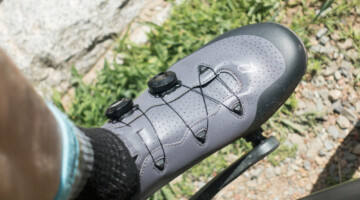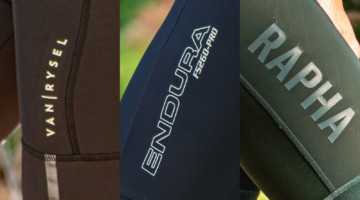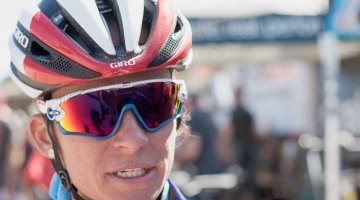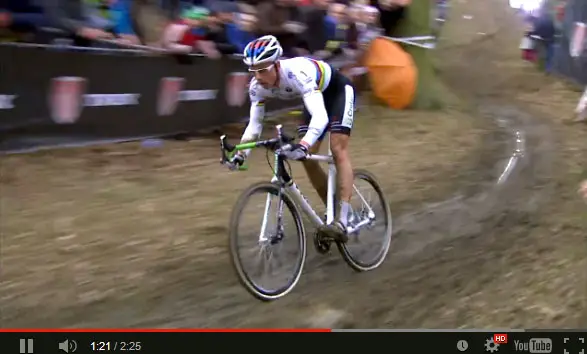
Video screenshot: Sven Nys racing the 2014 edition of his namesake race, and displaying the ideal cyclocross position over rough terrain
Properly sizing a cyclocross bike, as well as swapping or adjusting stems, saddles, handlebars, and seat posts for an ideal fit, are rich subjects that we have touched on before and will focus on again in the future. Even a bike with a perfect setup, however, won’t yield great results if a rider doesn’t properly position themselves on their bike. Today’s topic offers our Cyclocross 101 beginners some advice for putting their arms, legs, and torso in the right places to fully take advantage of the finessing of cyclocross.
All too often, I arrive in the morning to a cyclocross race just in time to see the lower categories take to the course, and I witness dozens of straight-armed riders with their rear ends glued to their saddles. Even in higher fields, at the end of the race when everyone is attempting to draw their last ounces of energy, they rely on their saddle around every corner even when their path is loaded with ditches, roots and rocks.
I am fully guilty of this as well. I suspect it comes naturally from road racing, where I consciously attempt not to waste a drop of energy on pavement by supporting my weight off my seat. Usually in a road race, getting out of the saddle is only reserved for sprinting or utilizing different muscle groups during a low cadence climb.
But cyclocross is a different animal. Conserving energy by remaining seated in a cyclocross race is the equivalent of thinking cyclocross tubulars are more efficient when pumped to their maximum recommended pressure (which is also a horrendous idea on race day).
Next time you are at a race, check out how the front of the pack in an elite race positions their body on their rigs. Most of them will have a firm grip on their handlebars, but their arms look nice and relaxed. As they come around curves with varied terrain like rocks and roots, most of them will hover over their saddle and others will even shift their body weight slightly behind their saddle. It’s a mistake to think that they are just trying to get in an aerodynamic position. These riders know that even though their cyclocross bikes don’t have suspensions, they can still use their arms and legs as a different kind of suspension.
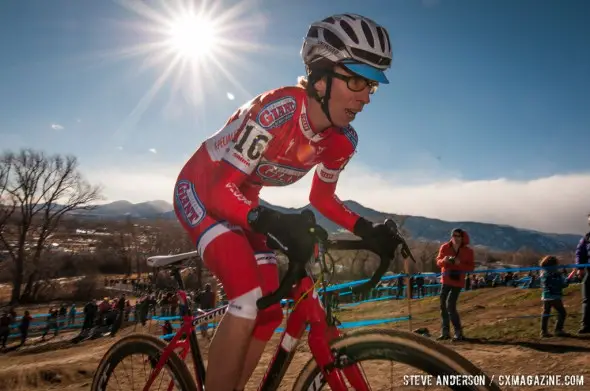
Rachel Lloyd, well-known for being a technical rider, knows the value of relaxed arms even in a climb at Cyclocross Nationals. © Steve Anderson
Should I be practicing an out-of-the-saddle position?
I was lucky enough to be able to listen in on Pete Webber’s advice a few weekends ago during his Cracking the Code clinic in New York City. As a methodical course designer and well-seasoned instructor, Webber has his students exaggerate a stance off their saddles and bend their elbows aggressively enough so that their chests are close to their handlebars. He recommends finding local pump tracks to train keeping both cyclocross wheels on the ground at all times. In the end, if you are practicing this position before cyclocross season begins, you will gain greater traction and greater efficiency on race day.
When you consider the physics behind this position on the bike, its efficiency makes sense. Even ignoring hyper lightweight bikes like the Ridley X-Night, when you total up the rider and their cyclocross bike, an overwhelming percentage of the total weight is still going to reside with the rider. Because of this, where the body is positioned is going to be a major factor of how the bike will handle. When you’re riding on the road and your rear wheel hits a speed bump with your butt fully glued on the saddle, you will discover that the back of your bike will go airborne. Your rigid seat tube and seat stays have no give, and so the force of hitting the speed bump is directly applied to your stationary mass, rocketing it upward.
Now when you approach the same speed bump with bent arms and bent legs, slightly unseated, the bike will still rise and fall beneath you, but the bulk of your mass in your torso remains far more level, using your legs and arms as buffers. Because this mass is far greater than that of your bike, the bouncing skyward effect doesn’t take place.
How does this apply on a cyclocross course?
Bumps, roots, ditches, rocks, and bizarre man-made objects are everyday affairs on race day. Your legs might be hollering at you that they can’t take any more abuse, they might complain that they need you to stay seated in a rough area, but they are going to be doing loads more work if you listen to them. Every time your body is jolted upwards or you feel that you are rattling around on a section, the external forces working on your bike are significantly slowing you down. If your forward power is suddenly changed into a few up and down jerks, your legs are going to have to put more power into your peals in order to keep pace with the technical-savvy rider ahead of you.
Your better standings won’t be the only change: your muscles will thank you too. Constantly relying on a seated posture and straight arms means that the force of impact will be delivered to the end points of a rigid position. In simpler terms, your lower back and shoulders are taking a massive beating when you’re not nice and relaxed riding over rough terrain. As an added bonus, in this relaxed posture, your chances of pinch flatting dramatically decrease, which in turn allows you to run at lower tire pressures, which in turn allows you to handle technical sections even better.
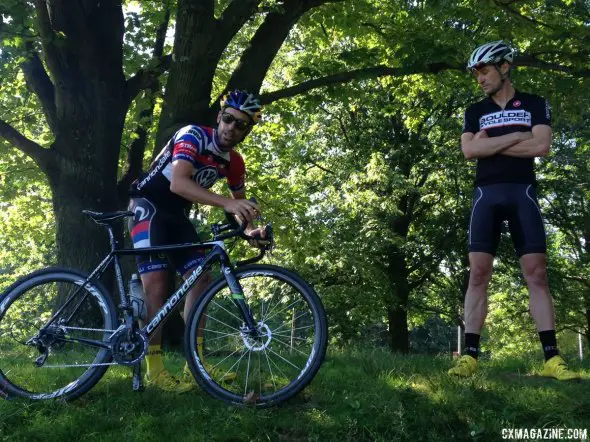
Pete Webber and Tim Johnson demonstrate proper positioning during their Cracking the Code clinic. © Cyclocross Magazine
Now is the perfect time to start practicing this posture for the season ahead. While you will discover that you have more traction coming around a corner when your wheel doesn’t bounce around, you will also have to relearn how to shift your body weight appropriately while cornering. Even after years of racing, I will usually spend the first few Wednesday Night World cyclocross practices eating dirt because my weight is too far forward or I shift my body weight too far into a corner.
Again, that’s what practice is for. Adam Myerson, a famous coach leading the Cycle-Smart programs, shares a great story on his website about one of his students reluctant to take a rather technical, muddy corner. When he asks her what she’s afraid of, she tells him she’s scared of falling. He looks at the corner and reminds her that she might fall, but is that such a bad worst-case scenario? Echoing Myerson, we would say that August is a great month for learning your limitations by testing new positions and taking them to their limits. Just make sure you find a muddy pit or a nice, soft patch of grass to fall onto.
Is there a time when staying seated is preferred during a technical section?
While this is a contested point, riding through a short section of sand is one technical place where you could easily remain seated. Staying in your saddle is one way of keeping your weight back and on the rear wheel, particularly when clear lines are not dug into the sand and you don’t know how your front wheel will react. The counter-point some could argue is that placing your weight slightly behind the saddle puts you in a position better suited to brace yourself against moving your weight forward when your bike suddenly slows down as it transitions from hard packed ground or grass to power-sapping sand. Like all things, try both ways and see what works more efficiently for you.
Get schooled in cyclocross with our Cyclocross Academy class list here, and make sure you’re subscribed to Cyclocross Magazine, your guide for getting into the sport, and upping your ’cross knowledge. Not subscribed yet? For the newbies, our Issue 21 has a great feature on buying your first cyclocross bike, and Issue 22 has a story on how to get into racing and what to expect at your first race.























